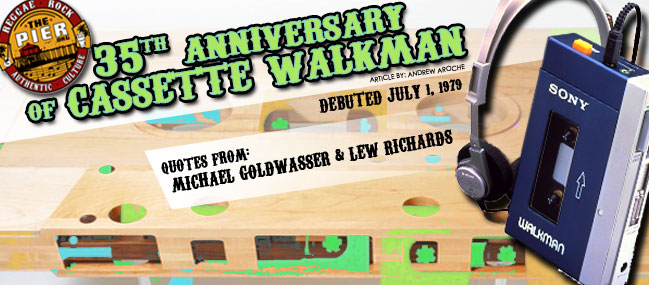
35th Anniversary of the Cassette Walkman
It was 35 years ago that Sony unknowingly changed the way the world experienced music. Biggie Smalls used it to let his tape rock ‘till his tape popped in the 80s, and more recently had Star Lord hooked on a feeling in Marvel’s summer blockbuster “Guardians of the Galaxy.” Although the Walkman wasn’t the first of it’s kind, a fourteen-ounce aluminum body and a hand-held design made it unique, and introduced society to music on the go.
Following a grand introduction in Japan in 1979, the Walkman TPS-L2 was released in 1980 to a different America from the one we know today. Colors were brighter, hair was bigger, and Pac Man was barely being introduced to the world. Because music had always remained within the bulky confines of a record player or a boombox, the Walkman’s compact size and mobility made it a hot commodity with people young and old, thus creating a new musical subculture.
Easy Star Records founder & Producer Michael Goldwasser recalls, “I still remember finally getting a Sony Walkman one day as a gift after having had several bigger and clunkier knockoffs. I couldn’t believe how small it seemed – not that much bigger than a cassette. Having a way to listen to music on the go was essential for a music freak like me, because I had an hour-and-a-half commute to and from school each day.” Michael, like many people, found the Walkman to be a necessity for long commutes, trips to the gym, or for some invaluable “me” time.
By today’s standards, it was no technological marvel, but the Walkman was incomparable to anything else during that time. With two AA batteries and their favorite cassette completely rewound, users were ready to take on the world with a Walkman clipped to their waist and those black, fuzzy earphones fitted snugly over their ears.

The Walkman had easily accessible control buttons alongside the device and two headphone jacks on top, in case users wanted to be social in their state of isolation. It even featured a “Hot Line” button, which simultaneously lowered the volume of the music while capturing outside noise with an external microphone, allowing users to hear the world around them without the burden of having to remove their headphones.
These features allowed people to completely immerse themselves in their music, especially 17th Street Recording Studio producer Lew Richards. “I just tuned out the world around me and would sink into the music,” says Richards, who accredits the Walkman for helping inspire him to become a musician. “I listened to the Beatles tapes going to and from catholic school in New Jersey everyday…its how l learned all the Beatles songs – then I got a guitar when I was 11 and learned how to play my favorite songs.”
For many years, cassettes were the primary source of audio for the Walkman. Before the Internet gave us the freedom to buy songs individually, people either recorded mixtapes from their boomboxes or would go to their local record store to buy the latest tapes from their favorite artists, which didn’t always go smoothly.
“While at sleepaway camp at age 13, I discovered the song ‘Baba O’Riley’ by The Who and I thought that it was cool as shit,” recalls Goldwasser. “So when I got home from camp at the end of the summer, I went to the local record store, but I couldn’t find it there so I asked if they could order the tape for me. They said that it was on The Who’s Greatest Hits, and sure, they could order it for me. I kept checking back with them every few days until they finally got it in. I was so excited to pick it up, only to find that the song wasn’t even on that album!”
Compared to vinyl records, cassettes didn’t have the same audio quality. Cassettes often had a scratchy, “room noise” accompanying the music while vinyl records sounded crisp and clean. Although the audio quality of vinyl was and still is highly sought after, quality was gladly sacrificed for mobility in this case. Over time, the Walkman evolved from simply playing cassettes to being able to record, pick up radio frequencies, and eventually play CDs. However, the original cassette Walkman will always bring back a sense of nostalgia for those who grew up with it.
“It’s amazing for me to think back to sitting on that bus or subway, tapping my feet to ‘Try Jah Love’, never even imagining that later on I would go on to meet my heroes, Third World and even record with Bunny Rugs,” says Goldwasser.
Because no one else felt there was a market for personal music players, Sony was able to capitalize on the phenomenon. There were plenty of secondary competitors like the Toshiba Walky and the Aiwa CassetteBoy, but the Walkman is the one that left it’s impression on pop culture, so much so, that it’s name was added to the Oxford Dictionary in 1986.
Like all electronic devices however, the Walkman eventually fell victim to newer technology. The release of the Apple iPod in 2001 pushed the Walkman into the realm of the obsolete, and by 2010, Sony decided to discontinue production, ending a thirty-one year run. While reading this may make us feel like we’ve taken too many trips around the sun, we can look back at products like the Walkman and think back to a simpler time, remembering how much inspiration and happiness we got from the seemingly advanced devices of yesteryear. Now we can only wonder what will come next.
Article By: Andrew Aroche
Watch: Kids React To Cassette Players

